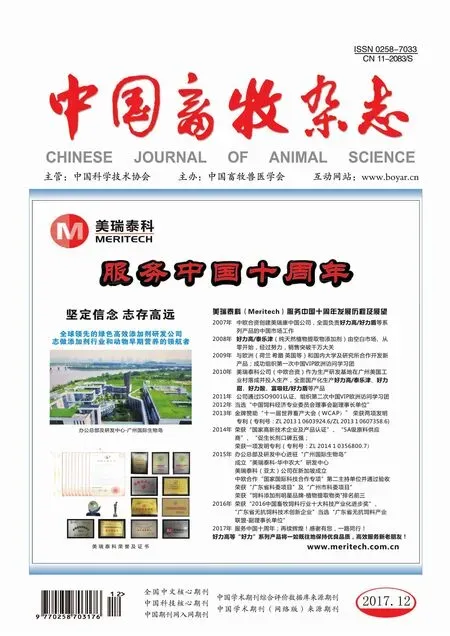精子发生中miRNAs调控功能研究进展
陈晓旭,曾文先
(西北农林科技大学动物科技学院,陕西杨凌712100)
特别报道
编者按
2017年《中国畜牧杂志》全面改版。为更好展示畜牧学领域的科技前沿,促进学术交流,本刊特别邀请不同领域的专家或青年骨干,围绕各自的研究领域,介绍自己、团队或国际研究机构近几年的研究成果、存在问题及研究展望,或就当前的研究热点问题进行讨论和评论。2017年第一期自副主编开始,将为读者带来相关综述,希望能引发读者对相关热点、难点的思考,并进行深入探讨。
精子发生中miRNAs调控功能研究进展
陈晓旭,曾文先*
(西北农林科技大学动物科技学院,陕西杨凌712100)
源源不断的精子发生过程是雄性繁殖机能的基础。精原干细胞(SSCs)持续不断地自我更新和分化又是精子发生的基础。精子发生起始于精原干细胞的分化,历经漫长的减数分裂后形成单倍体圆形精细胞。后者经过变态发育过程,最终形成精子并释放到曲细精管管腔中[1]。研究表明,成千上万的基因参与了精子发生过程,然而如何实现对这些基因精确有效的调控还有待研究。MicroRNAs(miRNAs)作为一类长度为22 nt的单链非编码小RNA,主要参与基因的转录后调控。近年来的研究表明,miRNAs参与调控雄性生殖细胞的增殖、分化以及凋亡。本文主要针对精子发生过程中miRNAs在睾丸不同细胞类型中的调控功能进行综述。
1 miRNAs的生成与作用机制
miRNAs的转录与其在基因组中的位置相关。在众多miRNAs基因中,大约有一半的miRNAs位于基因的内含子中,其转录调控与宿主基因一致或者不依赖于宿主基因。另外,部分miRNAs基因则成簇存在并共有相同的启动子,因此这些miRNAs基因具有相同的转录调控机制[2]。miRNAs基因转录成pri-miRNAs,经过Drosha和DGCR8的加工并生成pre-miRNAs。这些pre-miRNAs会在EXP5-Ran·GTP复合物的作用下运送至细胞质,进一步被Dicer加工成双链的RNA[3]。双链的RNA会在AGO蛋白形成的miRNA诱导沉默复合体中进一步成熟为具有生物学功能的miRNAs。miRNAs调控基因的表达主要通过碱基互补配对的方式诱导mRNA的降解或翻译抑制。这种调控识别方式主要依赖于成熟miRNAs第2~8位碱基的种子序列,因此,1个miRNA可以调控多个基因,同样的1个基因也可被多个miRNAs调控[4]。
最新的研究表明,N6-腺嘌呤甲基化修饰(m6A)参与调控miRNAs的生成。Alarcon等[5]报道,HNRNPA2B1能够结合pri-miRNAs的m6A修饰位点,并与DGCR8结合促进pri-miRNAs的加工;当细胞中缺少HNRNPA2B1或者m6A甲基化酶METTL3时,会导致细胞中未加工的pri-miRNAs水平上升,并降低成熟miRNAs的表达水平。因此,miRNAs生成受到m6A的调控。同时,miRNAs可以通过碱基互补配对的方式调控m6A修饰的形成。这种调控方式主要通过抑制METTL3与mRNA的结合,最终改变mRNA上的m6A修饰水平。m6A修饰水平的微妙变化能够改变mRNA的稳定性,从而调控基因的表达[6]。
2 miRNA在精子发生中的作用
2.1 Dicer条件性敲除模型鼠 Dicer条件性敲除模型鼠已被广泛应用于探究miRNAs在精子发生中的作用。Remero等[7]在出生前小鼠的原始精原细胞中敲除Dicer致使减数分裂异常、粗线期精母细胞凋亡、圆形精子减少以及精细胞形态异常。Koheron等[8]采用NGN3启动子驱动的Cre重组酶在A型精原细胞中敲除Dicer,则导致圆形精子细胞缺失,精子发生严重受阻;在早期精原细胞中Dicer的敲除也表现类似结果;在单倍体精子中敲除Dicer导致延长型精子以及精细胞的形态呈现异常,这些结果均表明miRNAs在精子发生调控中有着重要作用。
2.2 miRNA在精原干细胞自我更新及分化中的作用 SSCs位于睾丸曲细精管基部的微环境中,其自我更新与分化的平衡是确保雄性动物源源不断产生精子的基础,并受到多种因子调控。神经营养因子(GDNF)能够作用于细胞表面的RET和GFRα1受体,激活PI3K/AKT或者SFK信号通路,调控SSCs的自我更新[9]。miRNAs也参与SSCs自我更新调控。研究表明,miR-20、miR-21、miR-34c-135a、miR -146a、miR-182、miR-183、miR -204、miR-465a-3p、miR-465b-3p、miR-465c-3p、miR-465c-5p、miR-544在SSCs中高丰度表达[10-11]。其中,miR-20、miR-21和 miR-106a能 够 维 持 SSCs稳 态。Moritoki等[12]研究表明,miR-135a通过转录因子FOXO1的表达变化改变细胞表面膜受体RET蛋白的表达水平,进而调控SSCs的命运。而miR-544及miR-224均能够通过调控转录因子PLZF影响SSCs的自我更新[13-14]。另外,SSCs的增殖则受到miR-34c以及miR-204调控[15-16]。
研究表明,维甲酸能够诱导精原细胞的分化与减数分裂起始。维甲酸能够下调生殖细胞内miR-146、let7家族、miR-17-92、miR-106b-25和 miR-221/222表达水平[17-19]。其中,敲除miR-17-92导致SSCs以及精原细胞数量减少,并造成精子发生受损[19]。过表达miR-221/222能够抑制维甲酸诱导的精原细胞分化。此外,miR-34c靶向于NANOS并上调减数分裂相关基因,从而调控SSCs的分化和减数分裂过程[20]。
2.3 miRNA调控减数分裂以及精子变态发育 越来越多的证据表明miRNAs参与减数分裂的调控。miR-449 和miR-34b/c的表达水平均随着减数分裂的开始而上调。由于miR-449和miR-34b/c的种子序列相同,它们在调控精子发生中的作用有重叠,因此只有同时敲除miR-449和miR-34b/c才能导致精子发生障碍[21]。同时,miR-34b-5p能够调控Cdk6的表达以调控减数分裂过程[22]。类似地,miR-18作为精母细胞中高丰度表达的miRNA,也通过调控Cdk6调控精子发生过程[23]。
精子发生中组蛋白依次被过渡蛋白(TPs)以及精蛋白(PRMs)替换是雄性生殖细胞特有的发育过程[24]。在减数分裂后期的生殖细胞中,TPs以及PRMs的精确表达是精子变态发育的先决条件。因此,为了确保这一过程准确而有效地进行,TPs和PRMs受到严格的转录后调控。现已证实,miR-469能够抑制粗线期精母细胞以及圆形精子中TP2和PRM2的表达[25],而miR-122a则是在生殖细胞后期高丰度表达且调控TP2基因的表达[26]。
尽管大量的miRNAs会在精子变态发育过程中丢失,但是精子中残余的miRNAs同样具有重要功能。miR-34c参与受精卵第1次分裂过程[27],而精子中miR-424/322的表达紊乱诱导精子中双链分子的断裂[28]。通过探究弱精子症患者与正常人中精子表达的差异,人们确定了一些潜在的可作为不孕标记的miRNAs。以miR-151a-5p为例,miR-151a-5p在弱精子症患者中高表达且参与线粒体的生物学功能[29]。
2.4 miRNA在睾丸体细胞中的功能 精子发生同样依靠睾丸体细胞的参与,来源于支持细胞和间质细胞的细胞因子能够调控精子发生过程。因此,miRNAs对睾丸体细胞的调控也可影响精子发生过程。有研究指出,激素可诱导支持细胞miRNAs的表达水平变化,从而改变支持细胞的状态。例如雌二醇可诱导支持细胞miR-17和miR-1285的表达变化,从而调控支持细胞的增殖[30-31]。这种对于支持细胞增殖的调控也可通过miR-133b[32]和miR-762[33]的表达变化实现。睾丸间质细胞主要负责雄激素的生成,促黄体生成素(LH)诱导的雄激素生成过程会受到miRNAs的调控。miR-140-5p/3p能够控制小鼠睾丸间质细胞的数量,miR-140-5p/3p的缺失会导致间质细胞数量的增加[34]。
总的来说,miRNA通过调控支持细胞以及间质细胞的发育与功能,为SSCs的自我更新和分化创造了一个合适的微环境,为SSCs提供了结构以及营养支持。因此,睾丸体细胞中miRNAs同样在精子发生过程中有着重要的作用。
3 总结与展望
精确而有效地调控基因表达是精子发生正常进行的先决条件。研究证实,miRNAs在特定的细胞类型或精子发生阶段中表达,然而其中大部分miRNAs在精子发生中的功能还未阐明。第一,将来的研究可借助单细胞测序的方法,可更为准确地揭示特定生殖细胞类型中miRNAs的表达特点。条件性敲除技术以及CRISPR/Ca9技术的出现将能够进一步加快关于miRNAs功能的研究。第二,miRNAs在睾丸组织体细胞中的表达特点和作用还有待进一步阐明。睾丸体细胞中的miRNAs能否以旁分泌的方式分泌到SSCs微环境中,miRNAs能否调控睾丸体细胞生长因子的分泌进而影响生殖细胞发育,都需要进一步探究。第三,转录因子既能够调控SSCs的自我更新,也能够调控SSCs的分化,然而miRNAs调控转录因子表达的作用机制还需更深入研究。第四,m6A能够调控pri-miRNAs的加工,这为探究miRNAs生成调控和作用机制拓展了新的视野。在将来的研究中,探究生殖细胞发育中RNA表观修饰的变化将为更深刻地理解精子发生提供理论基础。最后,一些miRNAs已经被筛选为雄性不育的标记分子,阐明不孕不育患者中miRNAs标记分子的致病机理将有助于为男性不育提供新的疗法。总之,揭示这些问题将有助于更为深刻地认识和理解miRNAs在精子发生中的生物学作用。
[1]Rathke C, Baarends W M, Awe S,et al. Chromatin dynamics during spermiogenesis[J]. Biochim Biophys Acta, 2014,1839:155-168.
[2]Ramalingam P, Palanichamy J K, Singh A,et al. Biogenesis of intronic miRNAs located in clusters by independent transcription and alternative splicing[J]. RNA, 2014,20:76-87.
[3]Yi R, Qin Y, Macara I G,et al. Exportin-5 mediates the nuclear export of pre-microRNAs and short hairpin RNAs[J]. Genes Dev, 2003,17:3011-3016.
[4]Pasquinelli A E. NON-CODING RNA MicroRNAs and their targets: recognition, regulation and an emerging reciprocal relationship[J]. Nat Rev Genet, 2012, 13:271-282.
[5]Alarcon C R, Lee H, Goodarzi H,et al. N6-methyladenosine marks primary microRNAs for processing[J]. Nature,2015, 519:482-485.
[6]Alarcon C R, Goodarzi H, Lee H,et al. HNRNPA2B1 Is a mediator of m(6)A-dependent nuclear RNA processing events[J]. Cell, 2015, 162:1299-1308.
[7]Romero Y, Meikar O, Papaioannou M D,et al. Dicer1 depletion in male germ cells leads to infertility due to cumulative meiotic and spermiogenic defects[J]. PLoS One, 2011, 6: (10):e25241.
[8]Korhonen H M, Meikar O, Yadav R P,et al. Dicer is required for haploid male germ cell differentiation in mice[J]. PLoS One, 2011, 6:e24821.
[9]Oatley J M, Avarbock M R, Brinster R L. Glial cell linederived neurotrophic factor regulation of genes essential for self-renewal of mouse spermatogonial stem cells is dependent on src family kinase signaling[J]. J Biological Chem, 2007, 282:25842-25851.
[10]Niu Z Y, Goodyear S M, Rao S,et al. MicroRNA-21 regulates the self-renewal of mouse spermatogonial stem cells[J]. Proc Natl Acad Sci U S A, 2011,108:12740-12745.
[11]He Z P, Jiang J J, Kokkinaki M,et al. MiRNA-20 and mirna-106a regulate spermatogonial stem cell renewal at the post-transcriptional level via targeting STAT3 and Ccnd1[J]. Stem Cells, 2013, 31:2205-2217.
[12]Moritoki Y, Hayashi Y, Mizuno K,et al. Expression profiling of microRNA in cryptorchid testes: miR-135a contributes to the maintenance of spermatogonial stem cells by regulating FoxO1[J]. J Urol, 2014, 191:1174-1180.
[13]Song W, Mu H, Wu J,et al. miR-544 regulates dairy goat male germline stem cell self-renewal via targeting PLZF[J]. J Cell Biochem, 2015, 116:2155-2165.
[14]Cui N, Hao G, Zhao Z,et al. MicroRNA-224 regulates selfrenewal of mouse spermatogonial stem cells via targeting DMRT1[J]. J Cell Mol Med, 2016, 20(8):1503-1512.
[15]Li M, Yu M, Liu C,et al. miR-34c works downstream of p53 leading to dairy goat male germline stem-cell (mGSCs)apoptosis[J]. Cell Prolif, 2013, 46:223-231.
[16]Niu B W, Wu J, Mu H L,et al. miR-204 regulates the proliferation of dairy goat spermatogonial stem cells via targeting to sirt1[J]. Rejuvenation Res, 2016, 19:120-130.
[17]Huszar J M, Payne C J. MicroRNA 146 (Mir146) modulates spermatogonial differentiation by retinoic acid in mice[J].Biol Reprod, 2013, 88:15.
[18]Tong M H, Mitchell D, Evanoff R,et al. Expression of Mirlet7 family microRNAs in response to retinoic acidinduced spermatogonial differentiation in mice[J]. Biol Reprod, 2011, 85:189-197.
[19]Tong M H, Mitchell D A, McGowan S D,et al. Two miRNA clusters, Mir-17-92 (Mirc1) and Mir-106b-25(Mirc3), are involved in the regulation of spermatogonial differentiation in mice[J]. Biol Reprod, 2012, 86:72.
[20]Yu M, Mu H, Niu Z,et al. miR-34c enhances mouse spermatogonial stem cells differentiation by targeting Nanos2[J]. J Cell Biochem, 2014, 115:232-242.
[21]Bao J, Li D, Wang L,et al. MicroRNA-449 and microRNA-34b/c function redundantly in murine testes by targeting E2F transcription factor-retinoblastoma protein (E2F-pRb)pathway[J]. J Biol Chem, 2012, 287:21686-21698.
[22]Smorag L, Zheng Y, Nolte J,et al. MicroRNA signature in various cell types of mouse spermatogenesis: Evidence for stage-specifically expressed miRNA-221, -203 and -34b-5p mediated spermatogenesis regulation[J]. Biol Cell,2012, 104:677-692.
[23]Bjork J K, Sandqvist A, Elsing A N,et al. miR-18, a member of Oncomir-1, targets heat shock transcription factor 2 in spermatogenesis[J]. Development, 2010,137:3177-3184.
[24]Kleene K C. Patterns, mechanisms, and functions of translation regulation in mammalian spermatogenic cells[J]. Cytogenet Genome Res, 2003, 103:217-224.
[25]Dai L S, Tsai-Morris C H, Sato H,et al. Testis-specific miRNA-469 Up-regulated in gonadotropin-regulated testicular RNA helicase (GRTH/DDX25)-null mice silences transition protein 2 and protamine 2 messages at sites within coding region implications of its role in germ cell development[J]. J Biol Chem, 2011, 286:44306-44318.
[26]Yu Z R, Raabe T, Hecht N B. MicroRNA Mirn122a reduces expression of the posttranscriptionally regulated germ cell transition protein 2 (Tnp2) messenger RNA (mRNA) by mRNA cleavage[J]. Biol Reprod, 2005, 73:427-433.
[27]Liu W M, Pang R T, Chiu P C,et al. Sperm-borne microRNA-34c is required for the first cleavage division in mouse[J]. Proc Natl Acad Sci U S A, 2012,109:490-494.
[28]Zhao K, Chen Y, Yang R,et al. miR-424/322 is downregulated in the semen of patients with severe DNA damage and may regulate sperm DNA damage[J]. Reprod Fertil Dev, 2015, 28(10) 1598-1607.
[29]Zhou R, Wang R, Qin Y,et al. Mitochondria-related miR-151a-5p reduces cellular ATP production by targeting CYTB in asthenozoospermia[J]. Sci Rep, 2015, 5:17743.
[30]Kumar N, Srivastava S, Burek M,et al. Assessment of estradiol-induced gene regulation and proliferation in an immortalized mouse immature Sertoli cell line[J]. Life Sci, 2016, 148:268-278.
[31]Jiao Z J, Yi W, Rong Y W,et al. MicroRNA-1285 regulates 17beta-estradiol-inhibited immature boar sertoli cell proliferation via adenosine monophosphate-activated protein kinase activation[J]. Endocrinology, 2015,156:4059-4070.
[32]Yao C, Sun M, Yuan Q,et al. MiRNA-133b promotes the proliferation of human Sertoli cells through targeting GLI3[J]. Oncotarget, 2016, 7:2201-2219.
[33]Ma C P, Song H B, Yu L,et al. miR-762 promotes porcine immature Sertoli cell growth via the ring finger protein 4(RNF4) gene[J]. Sci Rep, 2016, 6:32783.
[34]Rakoczy J, Fernandez-Valverde S L, Glazov E A,et al.MicroRNAs-140-5p/140-3p modulate leydig cell numbers in the developing mouse testis[J]. Biol Reprod, 2013, 88(6):143.
10.19556/j.0258-7033.2017-12-001
国家自然科学基金(31272439、31572401)
陈晓旭(1992- )男,博士研究生,研究方向为动物遗传育种与繁殖,E-mail:chenxiaoxu1992@outlook.com
*通讯作者:曾文先,教授,博士生导师,研究方向为动物遗传育种与繁殖,E-mail:zengwenxian2015@126.com

